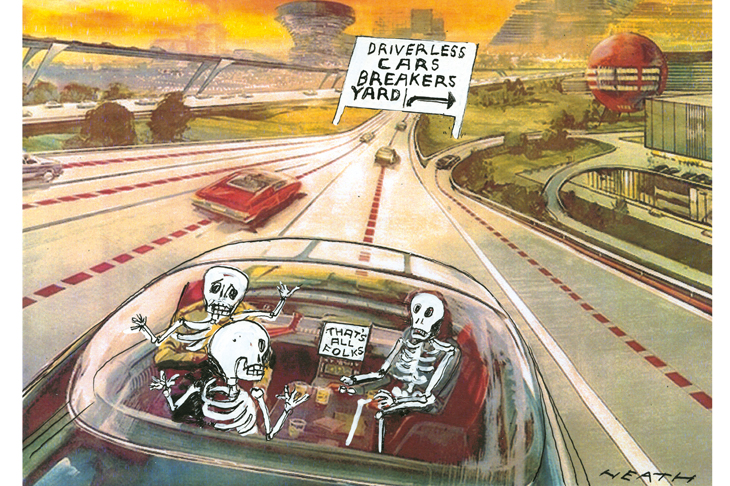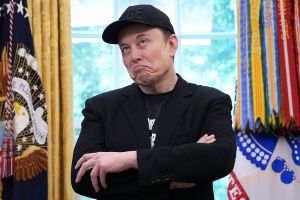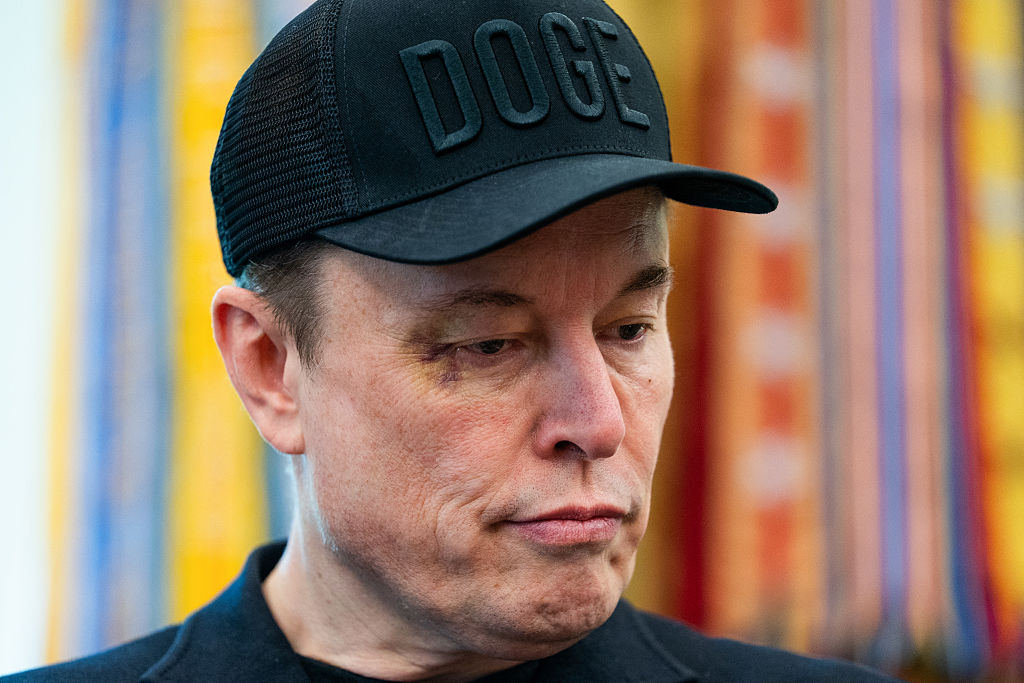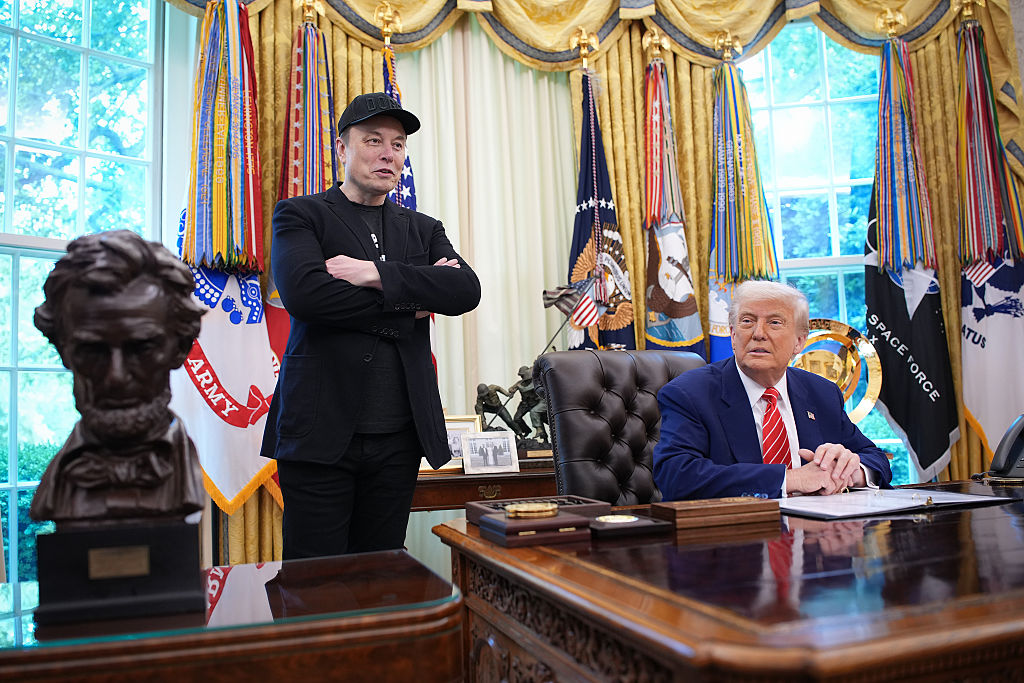I was worried that going to the autonomous vehicle exhibition in Stuttgart would be tantamount to an atheist walking into St Peter’s while the Pope was conducting a mass. There is something religious about the fervour with which adherents to the driverless credo practise their faith and promise us a new kingdom. Their proselytising has indeed convinced many. Politicians are making outlandish statements, such as Jesse Norman’s two weeks ago, that ‘Our entire use of roads is to be revolutionised by autonomous vehicles’, and pouring large sums — a promised £180 million so far — into bizarre research projects such as the development of strange robot cars slower than a Reliant Robin and allowed only on pavements in Milton Keynes.
The public, too, has been won over. Ask the average Joe in your local or even Basil in his club, and they will sing the praises of a technology that will apparently end carnage on the roads and allow them to check their Twitter accounts while being driven to work.
The assumption that this technology will soon transform our lives has been speeded along by gullible journalists who fail to look beyond the extravagant claims of the press releases pouring out of tech companies and auto manufacturers, hailing the imminence of major developments that never seem to materialise. Yet a careful reading of these announcements is sufficient to expose the limitations of what is actually being promised. As one of the exhibitors in Stuttgart explained to me: ‘The problem is that the marketing people get wind of something in the company and push it to the maximum without any real awareness of the limitations. That explains much of the hype.’
If the more extreme claims were to be believed, we would already be adapting to the new reality of driverless cars. And what a reality it is supposed to be. We are told by the likes of Uber and Waymo, Google’s autonomous vehicles wing, that we will forego our individual cars for the delights of being transported in driver-less, shared-use electric vehicles reminiscent of the new dockless hire bikes or car–sharing companies like Zipcar. This is a strange conflation of three separate revolutions, electric, shared use and driverless, each of which on its own would have enormous societal impact and yet are presented by the tech companies and some politicians as desirable and inevitable. In truth, all three concepts are fraught with obstacles, not least the shortage of battery capacity in the world, people’s natural desire to own their own vehicles, and everyone’s understandable hesitance about putting their lives in the hands of a computer.
The world of driverless vehicles is dominated by discussions around the six levels of autonomy. These range from none at all at Level 0 to Level 4, whereby cars drive themselves all the time but passengers retain controls such as pedals and the steering wheel in order to be able to take over when absolutely necessary, and Level 5, at which no human involvement at all is possible. The Holy Grail would be Level 4, as Level 3, at which drivers need to be constantly aware of what the car is doing, has proved to be unsafe because the person at the wheel becomes inattentive and fails to intervene promptly.
The auto manufacturers have, therefore, tended to focus their predictions on Level 4. Michael Hafner, Daimler’s head of Automated Driving, told Autonomous Vehicle International, a magazine handed out at Stuttgart, that: ‘In 2020/21, in addition to highly automated [Level 3] vehicles, we will also bring fully automated [Level 4/5] driving to market.’ Several other firms are making similar commitments, with 2021 — just far away enough for us to have forgotten about it once we get there — being a favourite, though others mention dates as late as 2025.
However, read those press releases carefully and for the most part they talk of trials, tests and pilot schemes, not the widespread introduction of these cars. The reality is that there are no driverless cars anywhere today, not even in Silicon Valley, in the sense of a vehicle that could be left to its own devices to navigate city streets or even an A road. Nearly all the ‘driverless’ cars on the roads have an operator on board to take over in the event of an error and these interventions are frequent. As the accident in which a woman was killed by an Uber vehicle being tested in Arizona shows, failure to intervene can prove fatal. Earlier this year, I wrote a short book, Driverless Cars: On a Road to Nowhere, based on my scepticism about this technological future. I therefore thought that the vast hall at the Stuttgart Messe, with its 80 exhibitors and 1,500 delegates, would be a hostile environment. I could not have been more wrong. Many were as sceptical as I am.
The exhibitors were nearly all suppliers to the industry, their names a mangle of the English language — Velodyne LiDAR, Spirent and Gestigon — and their products a tangle of abbreviations (ECU, ACC and V2X). Their wares ranged from the obvious, such as vehicle sensors, to the complex, like the radar testing equipment that was somehow linked to a simulation of a vehicle travelling at great speed on a motorway. There was hardware, too, such as a $300,000 device containing five cameras as well as Lidar (radar that uses laser signals) which, combined, could map a road down to the nearest millimetre. Also in the hall were the providers of testing methods, such as Spark, a 500-acre ‘facility’ for trialling driverless cars in Michigan that included a road tunnel to test equipment underground.
The OEMs (Original Equipment Manufacturers, the new name for vehicle makers) stayed away as they have nothing to show yet. Consequently, there were few cars and certainly none that were remotely driverless. One, a huge SUV, was there solely to demonstrate equipment that enables a driver to point at a building to find out its purpose, and if it were a restaurant to book a table, and if a cinema, to buy a ticket. Lars, who was demonstrating this with great enthusiasm, tried to convince me it would change my life. His argument lost further credibility when he let out the fact that the video he was using was actually from Grand Theft Auto. One of the other cars in the hall was a StreetDrone, not a driverless car but simply a version of the Renault Twizy that can be used to test various different autonomous features. They told me they had sold four. This hardly heralds the driverless revolution.
Surprisingly, I met more doomsayers than purveyors of the autonomous driving dream. The starkest warning came from Tim Mackey, who styles himself ‘senior technical evangelist’ for Black Duck Software, a company that specialises in security issues around autonomous vehicles. He believes there will be a seminal event that will stop all the players in the industry in their tracks. ‘We have had it in other areas of computing, such as the big data hacks and security lapses,’ he said, ‘and it will happen in relation to autonomous cars. At the moment, none of the big players are thinking properly about security aspects and then they will be forced to.’ He pointed to a video showing on another stand in which a man was calling up a car from a garage using a phone app: ‘That sort of thing is just too easy to hack. There’s all sorts of software put into cars that is old and easy to access. We just have to hope that the wake-up call will be minor and not kill anyone.’ Indeed, in a test a few years ago, hackers were able to get hold of a car’s steering and braking systems and Mackey is convinced that criminals will one day use the same method.
More widely, there was a general expectation these suppliers were riding the crest of a wave that will hit the rocks soon. While there is no doubting the scale of this industry, with billions being invested every year, none of the OEMs has yet made a penny from selling a driverless car. This money, benefiting these exhibitors, is therefore a punt, a high-stakes bet there is a pot of gold at the end of the rainbow. One, Johannes, told me: ‘I see a pattern like the dotcom boom. At some point, people are going to realise that the day when they start to get returns for their investment is far off, if ever. Then they will start pulling out and who knows how bad it will get. But the clever money will move somewhere else.’ The bad publicity caused by a couple of deaths in Tesla cars while its autopilot was engaged and by the Uber fatality may be seen as the start of public disenchantment with the concept.
While lots of these people may lose their livelihoods, there is a more damaging side-effect of this obsession. Johannes, who did not want his full name or the name of his company mentioned, added: ‘This area of science is taking up all the interest. I have a friend who nearly became an astronaut and she is a cosmologist, but now she is working on developing algorithms for these things. That is what everyone in the science world seems to be doing.’
This pursuit of the driverless car dream is therefore not only crowding out better ways of improving transport, but also stymying scientific development. Of the 20 or so exhibitors I spoke to, not a single one believed autonomous cars would be on our roads within a decade. There are a myriad problems, ranging from insurance issues to the limitations of the technology and the resistance of the public to travelling in them. Rather than swallowing the fatuous statements from politicians about how driverless cars are going to change our lives, we need a sober assessment of their potential benefits, if any, and, crucially, of their downsides.

























